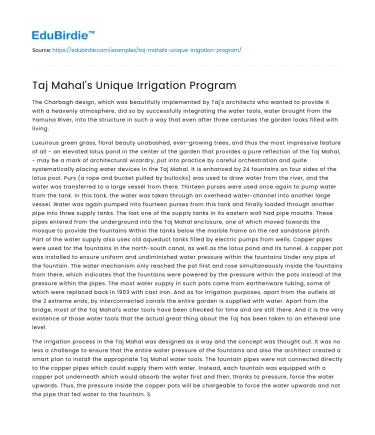The Charbagh design, which was beautifully implemented by Taj's architects who wanted to provide it with a heavenly atmosphere, did so by successfully integrating the water tools, water brought from the Yamuna River, into the structure in such a way that even after three centuries the garden looks filled with living.
Luxurious green grass, floral beauty unabashed, ever-growing trees, and thus the most impressive feature of all - an elevated lotus pond in the center of the garden that provides a pure reflection of the Taj Mahal, - may be a mark of architectural wizardry, put into practice by careful orchestration and quite systematically placing water devices in the Taj Mahal. It is enhanced by 24 fountains on four sides of the lotus pool. Purs (a rope and bucket pulled by bullocks) was used to draw water from the river, and the water was transferred to a large vessel from there. Thirteen purses were used once again to pump water from the tank. In this tank, the water was taken through an overhead water-channel into another large vessel. Water was again pumped into fourteen purses from this tank and finally loaded through another pipe into three supply tanks. The last one of the supply tanks in its eastern wall had pipe mouths. These pipes entered from the underground into the Taj Mahal enclosure, one of which moved towards the mosque to provide the fountains Within the tanks below the marble frame on the red sandstone plinth. Part of the water supply also uses old aqueduct tanks filled by electric pumps from wells. Copper pipes were used for the fountains in the north-south canal, as well as the lotus pond and its tunnel. A copper pot was installed to ensure uniform and undiminished water pressure within the fountains Under any pipe of the fountain. The water mechanism only reached the pot first and rose simultaneously inside the fountains from there, which indicates that the fountains were powered by the pressure within the pots instead of the pressure within the pipes. The most water supply in such pots came from earthenware tubing, some of which were replaced back in 1903 with cast iron. And as for irrigation purposes, apart from the outlets at the 2 extreme ends, by interconnected canals the entire garden is supplied with water. Apart from the bridge, most of the Taj Mahal's water tools have been checked for time and are still there. And it is the very existence of those water tools that the actual great thing about the Taj has been taken to an ethereal one level.
Save your time!
We can take care of your essay
- Proper editing and formatting
- Free revision, title page, and bibliography
- Flexible prices and money-back guarantee
The irrigation process in the Taj Mahal was designed as a way and the concept was thought out. It was no less a challenge to ensure that the entire water pressure of the fountains and also the architect created a smart plan to install the appropriate Taj Mahal water tools. The fountain pipes were not connected directly to the copper pipes which could supply them with water. Instead, each fountain was equipped with a copper pot underneath which would absorb the water first and then, thanks to pressure, force the water upwards. Thus, the pressure inside the copper pots will be chargeable to force the water upwards and not the pipe that fed water to the fountain. Since the pressure within the pots is distributed equally all the time, the smooth operation of the fountains around the garden was ensured. This was truly a mastermind's job and demanded not only quick thinking but also smooth design and planning. It is shocking that even during the conventional days, accustomed people come up with brilliant engineering and design ideas just to make sure the garden stays irrigated at all times. The principal water source was obtained from deep-laid earthenware pipes. One of those main pipes was located within the western canal. The garden was irrigated regularly through interconnected canals. The North-South canals and East-West canals used to be overflowing and hence the fountains supported these canal inlets.
The Taj Mahal has been said to be the only monument in the world to have such a planned program of irrigation that works to date.
Did you like this example?
Make sure you submit a unique essay
Our writers will provide you with an essay sample written from scratch: any topic, any deadline, any instructions.
Cite this paper
-
APA
-
MLA
-
Harvard
-
Vancouver
Taj Mahal’s Unique Irrigation Program.
(2022, December 15). Edubirdie. Retrieved December 22, 2024, from https://edubirdie.com/examples/taj-mahals-unique-irrigation-program/
“Taj Mahal’s Unique Irrigation Program.” Edubirdie, 15 Dec. 2022, edubirdie.com/examples/taj-mahals-unique-irrigation-program/
Taj Mahal’s Unique Irrigation Program. [online].
Available at: <https://edubirdie.com/examples/taj-mahals-unique-irrigation-program/> [Accessed 22 Dec. 2024].
Taj Mahal’s Unique Irrigation Program [Internet]. Edubirdie.
2022 Dec 15 [cited 2024 Dec 22].
Available from: https://edubirdie.com/examples/taj-mahals-unique-irrigation-program/
copy






 Stuck on your essay?
Stuck on your essay?

